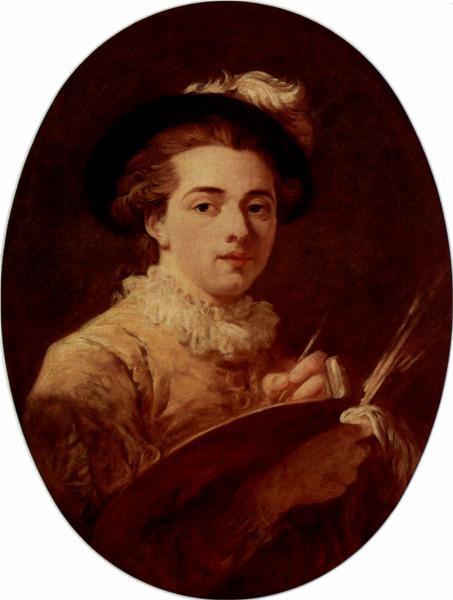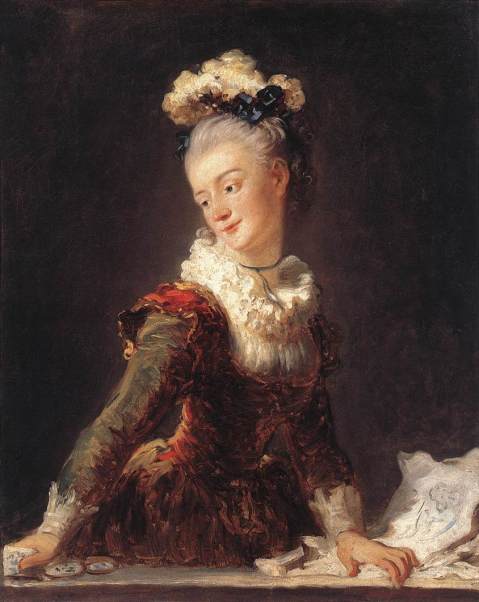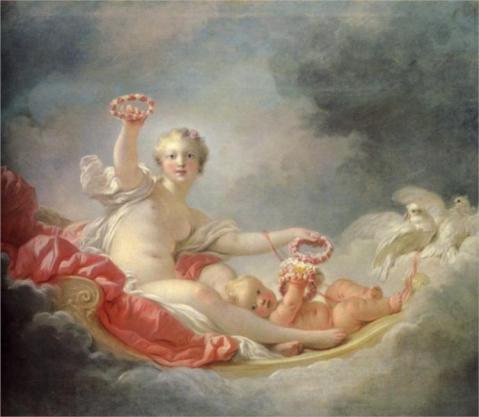Jean-Honoré Fragonard
 Fragonard was a French painter in the Rococo style. He was born in Grasse in 1732. His family moved to Paris when he was still a child. Eventually he worked as a notary clerk but was fired for always drawing. His mother took him to well-known rococo artist, Francois Boucher, who turned down Fragonard for an apprenticeship because he didn’t know how to paint.
Fragonard was a French painter in the Rococo style. He was born in Grasse in 1732. His family moved to Paris when he was still a child. Eventually he worked as a notary clerk but was fired for always drawing. His mother took him to well-known rococo artist, Francois Boucher, who turned down Fragonard for an apprenticeship because he didn’t know how to paint.
Jean-Baptiste-Siméon Chardin, a painter known for his still-life’s, did take Fragonard on as an apprentice and only 6 months later he was back at Boucher’s, this time as an apprentice. He eventually went to art school in Paris and Rome.
 In 1765 Fragonard presented his acceptance piece, “High Priest Coresus Sacrifices Himself to Save Callirhoë” to the Royal Academy. It was loved by the critics who saw him as a rising star in the French school of art.
In 1765 Fragonard presented his acceptance piece, “High Priest Coresus Sacrifices Himself to Save Callirhoë” to the Royal Academy. It was loved by the critics who saw him as a rising star in the French school of art.
 But at the next salon they were disappointed that he didn’t submit more serious historical paintings. Apparently he was seen as a sell out because he chose to do “boudoir” paintings such as his most well-known one, “Happy Hazards of the Swing”.
But at the next salon they were disappointed that he didn’t submit more serious historical paintings. Apparently he was seen as a sell out because he chose to do “boudoir” paintings such as his most well-known one, “Happy Hazards of the Swing”.
 This was painted for a member of Louis XV’s court who wanted a painting featuring his mistress.
This was painted for a member of Louis XV’s court who wanted a painting featuring his mistress.
Many of Fragonard’s paintings take place in lush, dark gardens. The Italian grottoes, villas and gardens he saw while he was in Italy as a student deeply influenced his style. It’s one of many reasons why I like his work. He’s so light and frothy, the way he paints light is magical at times. The darkness provides a light air of mystery to his often sweet and charming scenes.
 This is another early work of his from 1755. While the subject, colors and layout of this painting are all definitely Fragonard, the brushstrokes are feathery and rather broad. Throughout his career he could change his style on a whim.
This is another early work of his from 1755. While the subject, colors and layout of this painting are all definitely Fragonard, the brushstrokes are feathery and rather broad. Throughout his career he could change his style on a whim.
 Fragonard spent most of his career working for private patrons. Madame Du Barry, Louis XV’s mistress, commissioned 4 paintings from him (the theme was “The Progress of Love”) for her new music pavilion at her chateau in Louveciennes.
Fragonard spent most of his career working for private patrons. Madame Du Barry, Louis XV’s mistress, commissioned 4 paintings from him (the theme was “The Progress of Love”) for her new music pavilion at her chateau in Louveciennes.
However after he painted them she rejected them. I read that one reason was someone wanted the subjects in the paintings to have Du Barry’s and the King’s faces. LOL! I wasn’t able to find further evidence of that. The generally accepted theory is that by the time they were painted rococo was seen as a little old-fashioned…at least for Madame Du Barry.
 This is one of my very favorite paintings of his. Look at the light illuminating Aurora…she’s definitely preceding the sun!
This is one of my very favorite paintings of his. Look at the light illuminating Aurora…she’s definitely preceding the sun!
 Another favorite of mine where he’s showing almost impressionistic brushstrokes. Through the years critics and scholars agree that Fragonard was an artistic genius, often finishing a painting in an hour.
Another favorite of mine where he’s showing almost impressionistic brushstrokes. Through the years critics and scholars agree that Fragonard was an artistic genius, often finishing a painting in an hour.
 One of his patrons was a famous ballet dancer for the Comédie-Française, Marie-Madeleine Guimard. She had many wealthy lovers and in 1773 her new home was almost finished when she and Fragonard had a fight. He was supposed to do many paintings for her but she found a substitute. Since her home was still under construction, he walked in and on one portrait of Guimard as Terpischore (the role in which she made her debut) changed her smile to a grimacing frown without changing the likeness. Later when she arrived with a group of friends and saw what happened her face resembled Fragonard’s update to her portrait a little too well.
One of his patrons was a famous ballet dancer for the Comédie-Française, Marie-Madeleine Guimard. She had many wealthy lovers and in 1773 her new home was almost finished when she and Fragonard had a fight. He was supposed to do many paintings for her but she found a substitute. Since her home was still under construction, he walked in and on one portrait of Guimard as Terpischore (the role in which she made her debut) changed her smile to a grimacing frown without changing the likeness. Later when she arrived with a group of friends and saw what happened her face resembled Fragonard’s update to her portrait a little too well.
 Any image of this I found had Jacques-Louis David and Fragonard’s name attached. David was very interested in Fragonard so perhaps this was a copy David did of Fragonard’s original. Here is a Fragonard of Guimard:
Any image of this I found had Jacques-Louis David and Fragonard’s name attached. David was very interested in Fragonard so perhaps this was a copy David did of Fragonard’s original. Here is a Fragonard of Guimard:
 By the late 1770’s rococo was going out of style in favor of neo-classicism. Fragonard shifted accordingly but the French Revolution decimated his former patrons. Jacques-Louis David helped him out by getting Fragonard a job as a curator where he played a large role in founding what is now the Louvre.
By the late 1770’s rococo was going out of style in favor of neo-classicism. Fragonard shifted accordingly but the French Revolution decimated his former patrons. Jacques-Louis David helped him out by getting Fragonard a job as a curator where he played a large role in founding what is now the Louvre.
 Fragonard was eventually given a state pension in 1805, but he died a year later.
Fragonard was eventually given a state pension in 1805, but he died a year later.












